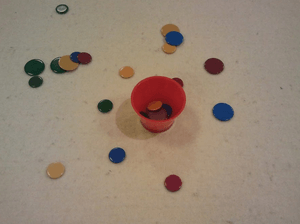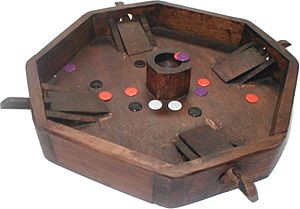Tiddlywinks facts for kids
 |
|
| Years active | 1888 to present |
|---|---|
| Genre(s) | Skill & action game |
| Players | usually 2 or 4; sometimes 3; 6 for a triples match |
| Setup time | 1 minute |
| Playing time | 30 minutes to an hour |
| Random chance | Low |
| Skill(s) required | Strategy, physical skill |
| Synonym(s) | Winks |
Tiddlywinks is a game played on a flat felt mat with sets of small discs called "winks", a pot, which is the target, and a collection of squidgers, which are also discs. Players use a "squidger" (nowadays made of plastic) to shoot a wink into flight by flicking the squidger across the top of a wink and then over its edge, thereby propelling it into the air. The offensive objective of the game is to score points by sending your own winks into the pot. The defensive objective of the game is to prevent your opponents from potting their winks by "squopping" them: shooting your own winks to land on top of your opponents' winks. As part of strategic gameplay, players often attempt to squop their opponents' winks and develop, maintain and break up large piles of winks.
Tiddlywinks is sometimes considered a simple-minded, frivolous children's game, rather than a strategic, adult game. However, the modern competitive adult game of tiddlywinks made a strong comeback at the University of Cambridge in 1955. The modern game uses far more complex rules and a consistent set of high-grade equipment.
Contents
Rules
Tiddlywinks is a competitive game involving four colours of winks. Each player controls the winks of a colour, the colours being blue, green, red and yellow. Red and blue are always partners against green and yellow. There are six winks of each colour, which begin the game in the corners of a felt mat measuring 6 feet by 3 feet. This mat is ordinarily placed on a table, and a pot is placed at its centre. There are two primary methods of play with the four colors of winks: a pairs game, and a singles game. The pairs game involves four players, playing in partnerships, with each winker playing a single color. The singles game involves a single winker playing against another single winker, each playing two colors of winks in alternation.
The players take turns, and there are two basic aims: to cover (or squop) opponent winks, and to get one's own winks into the pot. As in pool or snooker, if a player pots a wink of his own colour, then he is entitled to an extra shot, and this enables a skilled player to pot all of his winks in one turn. The point of squopping, which is the key element distinguishing the adult game from the child's game (though recognized in even the earliest rules from 1890), is that a wink that is covered (even partially) may not be played by its owner. The wink on top may be played, though, and sophisticated play involves shots manipulating large piles of winks.
The game ends in one of two ways: either all the winks of one colour are potted (a pot-out), or play continues up to a specified time limit (usually 25 minutes), after which each colour has a further five turns. Then a scoring system is used to rank the players, based on the numbers of potted and unsquopped winks of each colour.
National and international organisations
There are two national associations, the English Tiddlywinks Association (ETwA) and the North American Tiddlywinks Association (NATwA) (the Scottish Tiddlywinks Association having disbanded in the late 1990s). These organisations are responsible for conducting tournaments and maintaining the rules of the game (which actually differ only slightly between the two organisations; the NATwA rules are based on the ETwA rules). International competition is overseen by the International Federation of Tiddlywinks Associations (IFTwA), though in practice it is rarely called upon to intervene.
Competitive play
Although tiddlywinks nowadays is a singles or pairs game, competition in the 1950s until the 2000s centred on team competition, with teams consisting of several (two to four) pairs. There were a number of university teams, and international matches were also played. More recently, singles and pairs tournaments have come to be the focus of competitive tiddlywinks, with only a few team matches being played each year. The four most prestigious tournaments are the National Singles and National Pairs tournaments held in England and the United States. The World Singles and World Pairs championships operate on a challenge basis; anyone winning a national tournament (or being the highest-placed home player behind a foreign winner) is entitled to challenge the current champion.
There are several other less prestigious tournaments in England and the United States throughout the year, often with a format designed to encourage inexperienced players. The results of tournaments and world championship matches are used to calculate Tiddlywinks Ratings, which give a ranking of players.
Skill versus strategy, and comparable games
The important appeal of the game for many players is the required combination of manual dexterity and strategic thought as well as tactics. Tiddlywinkers often claim that the game combines physical skill (such as in snooker or golf) with the strategy of chess. Tiddlywinks is unique in the combination of skill and strategy it requires. Strategy in tiddlywinks is often rather deep, since winks can be captured. Strategic and tactical planning involves anticipating opponents' moves rather than just building a sequence of one's own moves. Another factor that complicates the game is that there is a time limit to the play of the game; it does not merely run until some objective in the game has been met.
All in all, tiddlywinks goes beyond the purely cerebral nature of a game such as chess. The fact that shots can be made or missed, together with the continuum of possible outcomes, makes strategy much less rigid than in chess, and prevents planning more than seven or eight shots in advance.
Equipment
The winks and pot used in competitive play are standard, and are supplied by the English Tiddlywinks Association. The pots are made of moulded plastic (historically always red, though there is no known reason for this), with specified diameters at the top and the base, and specified height. The winks are made in Italy to specified measurements, and are made by slicing an extruded cylinder rather than by moulding, and then smoothing them in a tumbler. Although this leads to some minor variation in thickness, it produces a much smoother edge to the wink than that seen on cheap moulded winks.
The mats are made of thick felt. Mats obtained from different suppliers have different characteristics, and part of the skill of a tournament player is to adjust to different mats.
Squidgers are custom-made by their owners or purchased from squidger makers. A player may use as many as he likes, selecting an appropriate squidger for each shot. Top players may carry up to twenty different squidgers, but will not typically use all of them in one game. The rules governing squidgers are liberal; a range of dimensions are permitted, and the material is not specified, except for the condition that squidgers must not damage either the winks or the mat. Typically squidgers are made from different types of plastic, though glass, rubber, cork and onyx are occasionally seen. The squidgers are usually filed or sanded to give a sharp edge and then polished.
Terminology
The game of tiddlywinks has a rich lexicon. Selected terms include:
Blitz: an attempt to pot all six winks of a given player's colour early in the game
Bomb: to send a wink at a pile, usually from distance, in the hope of significantly disturbing it
Boondock: to free a squopped wink by sending it a long way away, leaving the squopping wink free in the battle area
Bristol: a shot which moves a pile of two or more winks as a single unit; the shot is played by holding the squidger at a right angle to its normal plane
Carnovsky (US)/Penhaligon (UK): potting a wink from the baseline (i.e., from 3 feet away)
Cracker (UK): a simultaneous knock-off and squop, i.e. a shot which knocks one wink off the top of another while simultaneously squopping it
Crud (UK): a forceful shot whose purpose is to destroy a pile completely
Good shot: named after John Good. The shot consists of playing a flat wink (one not involved in a pile) through a nearby pile with the intent of destroying the pile
Gromp: an attempt to jump a pile onto another wink (usually with the squidger held in a conventional rather than a Bristol fashion)
John Lennon memorial shot: a simultaneous boondock and squop
Lunch: to pot a squopped wink (usually belonging to an opponent)
Scrunge (UK): to bounce out of the pot
Squidger: the disc used to shoot a wink
Squop: to play a wink so that it comes to rest above another wink
Sub: to play a wink so that it (unintentionally) ends up under another wink
Tiddlies: points calculated when determining the finishing placement of winkers in a tiddlywinks game
See also
 In Spanish: Pulga (juego) para niños
In Spanish: Pulga (juego) para niños



